9.6 Chi-Square Test for the Population Standard Deviation
OBJECTIVES By the end of this section, I will be able to …
- Perform the χ2 test for σ using the critical-value method.
- Perform the χ2 test for σ using the p-value method.
- Use confidence intervals for σ to perform two-tailed hypothesis tests about σ.
1 χ2 (Chi-Square) Test for σ using the Critical-Value Method
In Section 8.4, we used the χ2 distribution to help us construct confidence intervals for the population variance and standard deviation. Here, in Section 9.6, we will use the χ2 distribution to perform hypothesis tests about the population standard deviation σ. Why might we be interested in doing so? A pharmaceutical company that wants to ensure the safety of a particular new drug would perform statistical tests to make sure that the drug's effect was consistent and did not vary widely from patient to patient. The biostatisticians employed by the company would therefore perform a hypothesis test to make sure that the population standard deviation σ was not too large.
Under the assumption that H0:σ=σ0 is true, the χ2 statistic takes the following form:
χ2data=(n-1)s2σ20
Readers may want to review the characteristics of the χ2 distribution in Section 8.4 on page 474.
For the hypothesis test about s, our test statistic is called χ2data because the values of n-1 and s2 come from the observed data. The test statistic χ2data takes a moderate value when the value of s2 is moderate, assuming H0 is true, and χ2data takes an extreme value when the value of s2 is extreme, assuming H0 is true. This leads us to the following.
The essential idea About Hypothesis testing for the Standard Deviation
When the observed value of χ2data is unusual or extreme on the assumption that H0 is true, we should reject H0. Otherwise, there is insufficient evidence against H0, and we should not reject H0.
The remainder of Section 9.6 explains the details of implementing hypothesis testing for the standard deviation. The χ2 test for σ may be performed using the p-value method or the critical-value method. We begin with the critical-value method.
χ2 Test for σ : Critical-Value Method
This hypothesis test is valid only if we have a random sample from a normal population.
Step 1 State the hypotheses.
Use one of the forms in Table 13. State the meaning of σ.
Step 2 Find the χ2 critical value or values and state the rejection rule.
Use Table 13.
Step 3 Calculate χ2data.
Either use technology to find the value of the test statistic χ2data or calculate the value of χ2data as follows:
Page 557χ2data=(n-1)s2σ20
which follows a χ2 distribution with n-1 degrees of freedom, and where s2 represents the sample variance.
Step 4 State the conclusion and the interpretation.
If χ2data falls in the critical region, then reject H0. Otherwise do not reject H0. Interpret your conclusion so that a nonspecialist can understand.
The χ2 critical values in the right-tailed, left-tailed, or two-tailed tests use the following notations: χ2α, χ21-α, χ2α/2, and χ21-α/2 (see Table 13). In each case, the subscript indicates the area to the right of the χ2 critical value. Find these values just as you did in Section 8.4, using either technology or Table E, Chi-Square (χ2) Distribution, in the Appendix.
| Right-tailed test | Left-tailed test | Two-tailed test |
|---|---|---|
| H0:σ=σ0Ha:σ>σ0 | H0:σ=σ0Ha:σ<σ0 | H0:σ=σ0Ha:σ≠σ0 |
| Critical value:X2αReject H0 if X2data≥X2αlevel of significance α | Critical value:X21-αReject H0 if X2data≤X21-αlevel of significance α | Critical values:X2α/2 and X21-α/2Reject H0 if X2data≥X2α/2or if X2data≤X21-α/2level of significance α |
 |
||
EXAMPLE 31 χ2 test for σ using the critical-value method
carbonemissions8
| State | Carbon emissions (millions of metric tons) |
|---|---|
| Florida | 230.98 |
| Kentucky | 148.36 |
| Missouri | 135.54 |
| New Hampshire | 16.41 |
| New Mexico | 56.60 |
| New York | 166.32 |
| Tennessee | 105.73 |
| Virginia | 99.86 |
The table contains the carbon emissions from all sources for a random sample of eight states. Test whether the population standard deviation σ of carbon emissions differs from 60 million metric tons, using level of significance α=0.05.
Solution
The normal probability plot indicates acceptable normality.
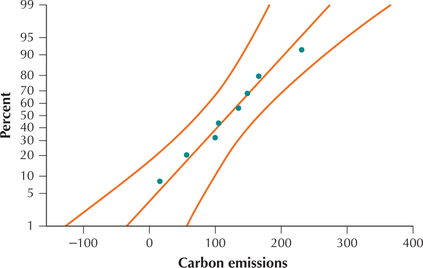
Step 1 State the hypotheses.
The phrase “differs from” indicates that we have a two-tailed test. The value σ0=60 answers the question “Differs from what?” (Note that σ0 is 60, and not 60,000,000 because the data are expressed in millions.) Thus, we have our hypotheses:
H0:σ=60versusHa:σ≠60
where σ represents the population standard deviation of carbon emissions in millions of metric tons.
Step 2 Find the χ2 critical values and state the rejection rule.
We have n=8, so degrees of freedom=n-1=7. Because α is given as 0.05, α/2=0.025 and 1-α/2=0.975. Then, from the χ2 table (Appendix Table E), we have χ2α/2=χ20.025=16.013, and χ21-α/2=χ20.975=1.690. We will reject H0 if χ2data is either ≥χ2α/2=16.013 or ≤χ21-α/2=1.690.
Step 3 Find χ2data.
The descriptive statistics in Figure 43 tell us that the sample variance is s2=4409.7 million metric tons, squared.
FIGURE 43 Descriptive statistics from Minitab.
Thus, our test statistic is:
χ2data=(n-1)s2σ20=(8-1)(4409.7)602≈8.57
Step 4 State the conclusion and the interpretation.
In Step 2, we said that we would reject H0 if χ2data was either ≥16.013 or ≤1.690. Because χ2data=8.57 is neither ≥16.013 nor≤1.690 (see Figure 44), we do not reject H0. There is insufficient evidence at level of significance α=0.05 that the population standard deviation of the state carbon emissions differs from 60 million.
Page 559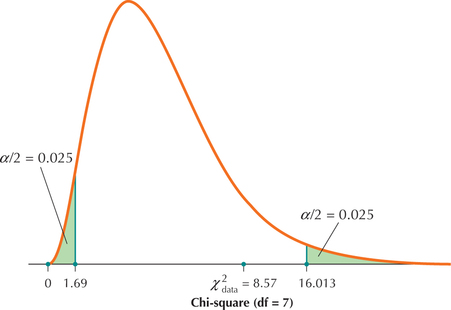 FIGURE 44 χ2data=8.57 does not fall in critical region, so do not reject H0.
FIGURE 44 χ2data=8.57 does not fall in critical region, so do not reject H0.
NOW YOU CAN DO
Exercises 7–12.
2 χ2 Test for σ Using the p-Value Method
We may also use the p-value method to perform the χ2 test for σ.
χ2 test for σ: p-value Method
This hypothesis test is valid only if we have a random sample from a normal population.
Step 1 State the hypotheses and the rejection rule.
Use one of the forms in Table 14. State the rejection rule as “Reject H0 when the p-value≤α.” State the meaning of σ.
Step 2 Calculate χ2data.
Either use technology to find the value of the test statistic χ2data or calculate the value of χ2data as follows:
χ2data=(n-1)s2σ20
which follows a χ2 distribution with n-1 degrees of freedom, and where s2 represents the sample variance.
Step 3 Find the p-value.
Use Table 14.
Step 4 State the conclusion and the interpretation.
If the p-value≤α, then reject H0. Otherwise, do not reject H0. Interpret your conclusion so that a nonspecialist can understand.
| Right-tailed test | Left-tailed test | Two-tailed test |
|---|---|---|
| H0:σ=σ0Ha:σ>σ0 | H0:σ=σ0Ha:σ<σ0 | H0:σ=σ0Ha:σ≠σ0 |
| p-value=P(X2>X2data)Area to right of X2data | p-value=P(X2<X2data)Area to left of X2data |
If P(X2>X2data)≤0.5, then
If P(χ2>χ2data)>0.05, then
|
 |
||
EXAMPLE 32 χ2 test for σ using the p-value method and technology
The table contains the calories in ten entrée food items, courtesy of Food-A-Pedia. Test whether the population standard deviation is larger than 100 calories, using level of significance α=0.05.
entreecalories
| Entrée item | Calories | Entrée item | Calories |
|---|---|---|---|
| Grilled steak | 387 | Ground beef (95% lean, medium patty) |
167 |
| Fried steak | 440 | Grilled pork chop (large) | 314 |
| Breaded fried steak | 600 | Fried pork chop (large) | 326 |
| Ground beef (75% lean, medium patty) |
234 | Meat pizza, thin crust, large | 325 |
| 1 large BBQ short rib with sauce | 148 | Fried catfish (breaded or battered) |
276 |
Solution
The normal probability plot in Figure 45 indicates acceptable normality, allowing us to proceed with the hypothesis test.
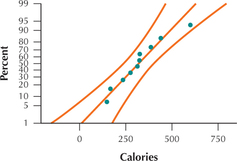
Step 1 State the hypotheses and the rejection rule.
The phrase “larger than” indicates that we have a right-tailed test. The question “Larger than what?” tells us that σ0=100, giving us
H0:σ=100versusHa:σ>100
We reject H0 if the p-value≤α=0.05.
Step 2 Find χ2data.
We use the Step-by-Step Technology Guide on page 562. The Minitab descriptive statistics in Figure 46 tell us that the sample variance is s2=17,742.5 calories squared.
 FIGURE 46 Calories descriptive statistics.
FIGURE 46 Calories descriptive statistics.Thus,
χ2data=(n-1)s2σ20=(10-1)(17,742.5)1002≈15.97
Step 3 Find the p-value.
For our right-tailed test, Table 14 tells us that
p-value=P(χ2>χ2data)=P(χ2>15.97)
That is, the p-value is the area to the right of χ2data=15.97, as shown in Figure 47. To find the p-value, we use the instructions provided in the Step-by-Step Technology Guide provided at the end of this section. The TI-83/84 results shown in Figure 48 tell us that p-value=P(χ2>15.97)=0.0675107153≈0.0675.
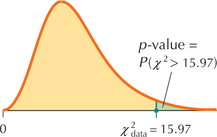 FIGURE 47 p-Value for χ2 test
FIGURE 47 p-Value for χ2 test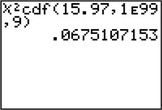 FIGURE 48 TI-83/84 results.
FIGURE 48 TI-83/84 results.Step 4 State the conclusion and the interpretation.
Because p-value=0.0675 is not ≤α=0.05, we do not reject H0. There is insufficient evidence that the population standard deviation is greater than 100 calories.
NOW YOU CAN DO
Exercises 13–18.
3 Using Confidence intervals for σ to Perform Two-Tailed Hypothesis Tests for σ
Suppose we have a 100(1-α)% confidence interval for σ, of the form (lower bound, upper bound), and are interested in two-tailed hypothesis tests using level of significance α of the form:
H0:σ=σ0versusHa:σ≠σ0
We will not reject H0 for values of σ0 that lie between the lower bound and upper bound of the confidence interval, and we will reject H0 for values of σ0 that lie outside this interval.
EXAMPLE 33 Using confidence intervals for σ to conduct two-tailed χ2 tests for σ
A 95% confidence interval for the population mean sodium content of breakfast cereals, in milligrams (mg) per serving, is given by
(44.53 mg,81.50 mg)
Assume that the data are normally distributed. Test, using level of significance α=0.05, whether σ differs from the following.
- 80 mg
- 40 mg
Solution
- For the hypothesis test H0:σ=80 versus Ha:σ≠80,σ0=80 lies between the lower bound 44.53 and the upper bound 81.50 of the confidence interval, and we therefore do not reject H0. There is insufficient evidence that the population standard deviation of sodium content differs from 80 mg.
- For the hypothesis test H0:σ=40 versus Ha:σ≠40,σ0=40 lies outside the confidence interval, and we therefore reject H0. There is evidence that the population standard deviation of sodium content differs from 40 mg.
NOW YOU CAN DO
Exercises 19–22.